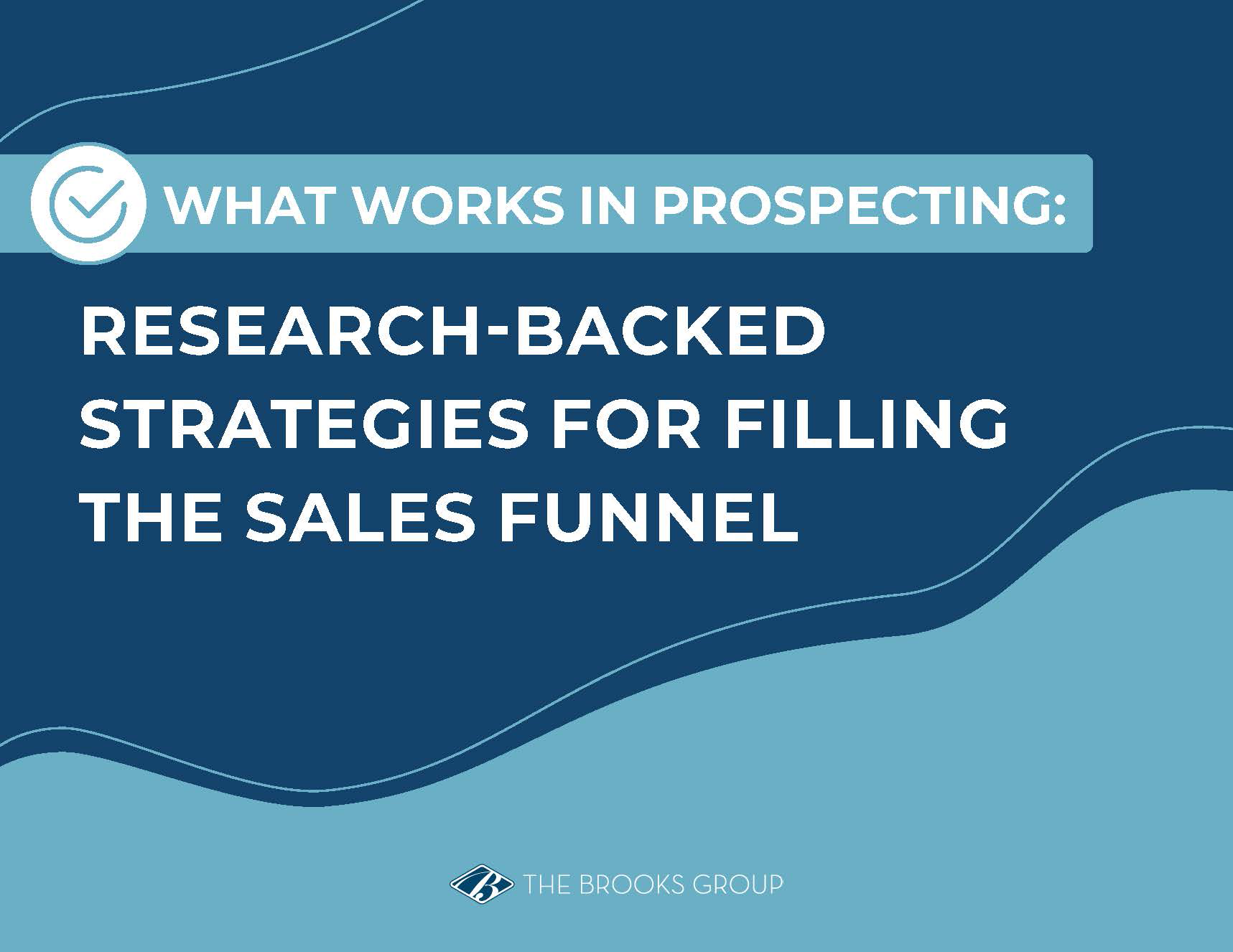You know prospecting is a make-or-break skill. But did you know it’s one of the shared strengths of top sales professionals? Find out how to give your team an edge with sales prospecting training.
In a recent conversation with a client, I found out his high-performing sellers all had one thing in common: They were good at prospecting. Through economic ups and downs, these sales professionals continue to lead the pack.
How do they manage to stay at the top, even in a down economy? What attributes contribute to their success?
The shared skill of leading sales professionals is strong prospecting techniques. In the case of each stand-out performer, they had these seven characteristics:
- They have a formal, personal prospecting plan.
- They take action to implement the plan.
- They—not their sales manager—set their own personal goals.
- They review results regularly to determine if they’re meeting goals.
- They have the flexibility to tweak the plan as needed.
- They’re disciplined enough to follow their plan.
- They’re skilled at several prospecting techniques.
This post dives into these seven attributes and shows how sales prospecting training can help your team succeed no matter what the market does.
Help Your Sales Team Prospect Smarter, Not Harder
In competitive markets, the key to success is to have a plan, take appropriate action, and remain flexible so you can course-correct. Above all, it’s critical to have the discipline to stay the course.
But sales professionals are generally fast-paced and enjoy selling more than planning. Motivating them to be disciplined around prospecting can be a challenge.
The first step is getting your team to dedicate time to focus on pre-call planning. Simply setting aside time for prospecting won’t guarantee success, however.
Your sales professionals need to engage in prospecting activities that will result in high-quality lead generation. “Activity for the sake of activity” may feel productive, but that doesn’t mean it is.
Coach your sellers on these strategic prospecting techniques to make sure they squeeze the most value out of their planning time.
Hyper-Focus on the Characteristics of a Qualified Buyer
There are always buyers who are looking for precisely the type of solution your organization provides. It’s just a matter of finding them, connecting with them at the right time, and articulating a perfectly tailored message.
Coach your sales professionals to get 110% clear about the characteristics of a qualified prospect and they’ll be able to aim with precision rather than feeling around in the dark for the first thing they bump into.
Get your team members to analyze their top customers and develop prospect profiles based on those common characteristics. The more focused your sellers are in their search, the better chance they have of finding a highly qualified lead (and winning their business).
This exercise will put your team in your customers’ shoes and allow your team to tailor the most effective messaging. It will also help them figure out the best places to search for similar buyers—and the best approaches to use once they find them.
Focus on Prospect Quality, Not Size
It’s easy to fall into the trap of pursuing only big deals, but your sellers need a well-diversified mix of small, medium, and large prospects to keep the funnel full.
That’s not to say your sales professionals should never take a chance on a marquee account, but with a larger time commitment and longer sales cycle comes greater risk, including lost time and energy if the opportunity isn’t won.
Regardless of size, prospects aren’t worth going after unless they meet your organization’s ideal customer criteria. Just as your team members shouldn’t veer off course chasing a large, underqualified prospect, neither should they let a well-qualified prospect slip by them simply because they’re too small.
Small victories are still victories, and they not only contribute to reaching quota; they also provide motivation for keeping up the momentum. Make sure your sellers eliminate any prospects that don’t fit the ideal customer criteria. Then they can begin to prioritize and allocate resources to maximize profitability.
Perfect Your Team’s Statement of Intention
Once your team members have identified the right person, one of the next toughest aspects of prospecting is getting an appointment. We’ve all had the experience of unreturned phone messages and emails.
I can’t give you the magic tool that will make every prospect call back or reply, but I can improve your odds significantly with one tip: Try using a statement of intention.
A statement of intention is the first step of a value-based selling approach. It’s a short summary of the value you bring to customers who are similar to the prospect you’re hoping to sell to. It can be used in a voice mail, face-to-face, or over the phone.
When you call a prospect, what goes through their mind? Use a statement of intention to answer these questions quickly and effectively.
- Who are you?
- What company do you represent?
- What’s in it for me?
Here’s an example:
“My name is Richard Liles, with The Brooks Group. We help companies in the manufacturing industry implement a consistent sales process and grow their client base. We do this by providing customized sales training reinforced with practical, real-world coaching.”
See how it works? My name is [your name] with [your company]. We help companies in the [industry] to [results statement]. We do this by [solution description].
Your team members should each develop and practice a consistent statement of intention so it flows easily and naturally when they need it—whether they’re calling, networking at an event, or meeting someone at a party.
Leverage the Power of LinkedIn
Your sales professionals may understand the necessity of networking, but they may not be taking advantage of the capabilities that are literally available at their fingertips: social media.
On LinkedIn, for instance, your first-level contacts can give you access to a wide range of second- and third-level connections. Your sales professionals can increase their reach exponentially and with minimal effort—giving them the most bang for their time spent prospecting.
Beyond discovering important company announcements or news on social media, conducting some strategic detective work will allow your sellers to learn about decision makers within their target accounts. A bit of searching can reveal a lot about the people your sellers need to influence to make a sale.
Improve Results with Sales Prospecting Training
Your sales professionals need to devote time and effort to filling their pipeline of prospects. As a sales leader, however, you’re responsible for making sure your team is focused on the high-gain sales training activities that maximize results.
Sales prospecting training will give your team the skills and strategies to focus on the right people and companies consistently—and keep sales performance at a high level.
Find out how The Brooks Group Prospecting Strategies workshop equips sales professionals with cutting-edge strategies and practical tools to excel at prospecting.
White Paper Download
What Works in Prospecting
There are many variables that impact the success or failure of a sale. Do your sellers risk the sale by making assumptions about the buyer?
Gain insight into the survey results from over 300 buyers and sellers, from individual contributors to CEOs, that will help your sales team improve their prospecting effectiveness.





